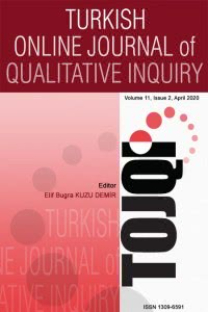Integrating Multiple Intelligences into Daily Plans: A Preschool Example
Çoklu Zeka Kuramı’nı Günlük Planlara Entegre Etme: Bir Anaokulu Örneği
___
Aronoff, F. W. (1988). Reaching the young child through music: Howard Gardner’s Theory of Multiple Intelligences as model. International Journal of Music Education, 12(1), 18-22.Bednar, J. (2002). Improving student motivation and achievement in mathematics through teaching to the Multiple Intelligences. Master’s Thesis. Chicago: Saint Xavier University.
Birchfield, D., Thornburg, H., Megowan-Romanowicz, C., Hatton, S., Mechtley, B., Dolgov, I., & Burleson, W. (2008). Embodiment, multimodality, and composition: Convergent themes across HCI and education for mixed-reality learning environments. Journal of Advances in Human-Computer Interaction, 2008, 1-19.
Bordelon, D. E., & Banbury, M. M. (2005). Pursuing the parameters: Validating the Multiple Intelligences Inventory for teachers. Assessment for Affective Intervention, 30, 33-51.
Carlisle, A. (2001). Using Multiple Intelligences Theory to assess early childhood curricula. Young Children, 56(6), 77-83.
Checkley, K. (1997). Teaching for Multiple Intelligences: A conversation with Howard Gardner. Educational Leadership, 55(1), 12.
Chen, J., Moran, S., & Gardner, H. (2009). Multiple intelligences around the world. New York: Jossey-Bass.
Delgoshaei, Y., & Delavari, N. (2012). Applying multiple-intelligence approach to education and analyzing its impact on cognitive development of pre-school children. ProcediaSocial and Behavioral Sciences, 32, 361-366.
Economidou Stavrou, N., Chrysostomou, S., & Socratous, H. (2011). Music Learning in the Early Years: Interdisciplinary Approaches Based on Multiple Intelligences. Journal for Learning through the Arts, 7(1), 1-14.
Erkan, S., & Öztürk, B. (2013). A study on the multiple intelligences of kindergarteners from different socioeconomic backgrounds. Procedia - Social and Behavioral Sciences, 106, 250-258.
Fleetham, M. (2009). Multiple Intelligent Applications. Retrieved April 25, 2018, from http://www.thinkingclassroom.com/Parents/MI_Applications_Resources.aspx Furnham, A., & Thomas, C. (2004). Parents’ gender and personality and estimates of their own and their children’s intelligence. Personality and Individual Differences, 37, 887-903.
Gardner, H. (1983). Frames of mind: The theory of Multiple Intelligences. New York: Basic Books.
Gardner, H. (1993). Frames of mind: The theory of Multiple Intelligences. (10 anniversary ed.). New York, NY: Basic Books.
Gardner, H. (1999). The disciplined mind: What all students should understand. New York: Simon & Schuster. Gardner, H. (2006a). Multiple intelligences: New horizons. New York: Basic Books.
Gardner, H. (2006b). Replies to my critics. In J. A. Schaler (Ed.). Howard Gardner under fire: The rebel psychologist faces his critics. (pp. 277-344). Chicago: Open Court.
Gardner, H., & Hatch, T. (1989). Multiple Intelligences go to school: Educational implications of the Theory of Multiple Intelligences. Educational Researcher, 18(8), 4-9.
Guss, F.G. (2005). Dramatic playing beyond the Theory of Multiple Intelligences. Research in Drama Education, 10(1). 43-54.
Gündüz, N., & Özcan, D. (2017). The Development of Multiple Intelligence with Storytelling. International Journal of Educational Sciences, 15(1-2), 242-251.
Highland, S. (1999). Improving student behavior through the use of Multiple Intelligences. Master’s Thesis. Chicago: Saint Xavier University.
Jiang, F. (2011). Selection of Kindergarten Curriculum Content under the New Curriculum Ideas. Journal of Changsha Normal College, (4), 9-21.
Kuo, C.C., Su, F.L., & Maker, C. J. (2011). Cultivating Problem Solving Abilities in Gifted Preschoolers. Gifted Education International, 27(3), 311-326.
Lai Imm, J.L., & Bahauddin, A. (2008) The Effects of Colours on Preschoolers’ Behaviour: An analysis of Colour-Mood Association on Preschoolers Aged 4 to 6. In: 2nd International Conference on Built Environment in Developing Countries, 3rd -4 th December 2008, Universiti Sains Malaysia, Pulau Pinang.
Ministry of National Education. (MONE) (2006). Preschool Education Curriculum (For 36 through 72 Months Old Children). Ankara: MEB Publications.
Norel, M., Niculescu, R. M., Usaci, D., & Lupu, D. (2009). Valuing the Theory of Multiple Intelligences in Formal Curriculum. New Trends. In Proceedings of the 11th WSEAS İnternational Conference On Mathematical Methods And Computational Techniques In Electrical Engineering (pp. 441-445). World Scientific and Engineering Academy and Society (WSEAS).
Özdemir Beceren, B. (2010). Determining multiple intelligences pre-school children (4-6 age) in learning process. Procedia - Social and Behavioral Sciences, 2(2), 2473-2480.
Padurean, A. (2011). Interactive Teaching Methods for Pre-School and Primary School Pupils. Journal Plus Education/Educatia Plus, 7(2), 156-163.
Rettig, M. (2005). Using the Multiple Intelligences to enhance instruction for young children and young children with disabilities. Early Childhood Education Journal, 32(4), 255- 260.
Silver, H., Strong, R., & Perini, M. (1997). Integrating learning styles and Multiple Intelligences. Educational Leadership, 55(1), 22-27.
- ISSN: 1309-6591
- Yayın Aralığı: 4
- Başlangıç: 2010
- Yayıncı: Prof.Dr. Abdullah Kuzu
Teaching as a Professionalism through Teachers’ Perspective
Tuncay Yavuz ÖZDEMİR, Murat DEMİRKOL, Hakan POLAT
Integrating Multiple Intelligences into Daily Plans: A Preschool Example
Tanju GÜRKAN, Çağlayan DİNÇER, Burcu ÇABUK
Bir Lisanüstü Uygulamalı Dilbilim Programına Yönelik Öğrenci Memnuniyeti Araştırması
Selma Yılmaz, Şakire Erbay Çetinkaya
Öğretmen Görüşleriyle Öğretmen Profesyonelliğinin İncelenmesi
Tuncay Yavuz Özdemir, Hakan Polat, Murat Demirkol
An Investigation of Student Satisfaction with an Applied Linguistics Graduate Programme
Şakire ERBAY ÇETİNKAYA, Selman YILMAZ
Çoklu Zeka Kuramı’nı Günlük Planlara Entegre Etme: Bir Anaokulu Örneği
